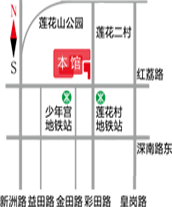
- Guan Shanyue and Guangzhou Academy of Fine Arts
-
From the founding of the People's Republic of China to the mid-1960s, Mr. Guan Shanyue has been engaged in the teaching of Chinese painting and served as the leadership of the Academy. In July 1958, Mr. Guan Shanyue, 47 years old, moved from Wuhan to Guangzhou with his family along with Central and South America College. The Central South American College was renamed as Guangzhou Academy of Fine Arts, and the campus was built at Liu Wang Diangang (now Changgang Station), a mountain village on the south bank of the the Pearl River. Ren served as the Vice President and Director of the Department of Chinese Painting at Guangzhou Academy of Fine Arts, personally responsible for the teaching of character courses in the Department of Chinese Painting. Since then, he has made outstanding contributions to the development of art education in New China, especially the establishment of the discipline of Chinese painting and the establishment and improvement of the teaching system at Guangzhou Academy of Fine Arts. His important articles on the teaching practice of Chinese painting, such as "Several Issues on Basic Training of Chinese Painting" and later "Teaching and Learning to Develop New Paths," systematically elaborated on the relationship between concepts and methods, theory and practice, teaching content and teaching forms in Chinese painting teaching, laying a preliminary theoretical foundation for the teaching of Chinese painting at Guangzhou Academy of Fine Arts. And on this basis, use creativity to reflect a new life and express a new era.
Excerpt from the Events of Guan Shanyue's Activities at Guangzhou Academy of Fine Arts
In July 1985, Guan Shanyue moved from Wuhan to Guangzhou with the Central and South American College, now known as Guangzhou Academy of Fine Arts, and served as the Vice Dean and Director of the Department of Chinese Painting. In March 1960, he led the graduating class of the Chinese Painting Department of Guangzhou Academy of Fine Arts to work at the Zhanjiang Sea Blocking Construction Site for three months. After returning to school, the teachers and students collectively created a large-scale Chinese painting called "Declaration of War on the Ocean". In 1962, took students to the Chaoshan area to sketch. In March 1963, went to Shanwei Fishing Port and other places to sketch from life. Create "Fisherman's Song", "Spinning Diagram", and "Fast Horse Whips Not Off Saddle". In 1963, his works "Dongfeng" and "Fruit Town" participated in the "Guangzhou Academy of Fine Arts Teachers and Students Going to the Countryside Exhibition" at the China National Art Museum. Subsequently, due to the Cultural Revolution, Mr. Guan Shanyue was forced to leave his teaching position and was appointed as a special consultant by the Academic Committee of Guangzhou Academy of Fine Arts until December 1980. On December 3, 1987, he participated in the groundbreaking ceremony of the Lingnan School of Painting Memorial Hall at Guangzhou Academy of Fine Arts and received the Guangdong Lu Xun Literature and Art Award for the collaboration of Zhao Shaoang, Li Xiongcai, Guan Shanyue, and Yang Shanshen. Donate all the 4000 yuan prize money to the Lingnan Painting School Memorial Hall Foundation. After returning from his visit to the United States in 1990, he donated the manuscript fee to Guangzhou Academy of Fine Arts to establish the "Guan Shan Yue Chinese Painting Teaching Fund" to reward those who have achieved success in teaching and learning Chinese painting. On June 8, 1991, the Lingnan School of Painting Memorial Hall was completed at Guangzhou Academy of Fine Arts, and he served as the Chairman of the Board of Directors of the Lingnan School of Painting Memorial Hall. In 1993, seven teachers from Guangzhou Academy of Fine Arts were awarded the "Guanshan Yue Chinese Painting Teaching Fund" for the first time. Mr. Guan Shanyue has been awarded the title of lifelong professor by Guangzhou Academy of Fine Arts. In July 1996, Mr. Guan Shanyue was invited by Guangzhou Academy of Fine Arts to give a speech on "Commemorating the 50th Anniversary of the Victory of the Anti Japanese War" to all teachers and students. The opening ceremony of the "Mr. Guan Shanyue Donation Exhibition" and the teacher-student seminar was held on November 8, 1996 at the Lingnan Painting School Memorial Hall of Guangzhou Academy of Fine Arts. The 145 works donated this time are all created in combination with teaching in the 1960s, mainly featuring character paintings. Mr. Guan Shanyue passed away in July 2000 at his home at Guangzhou Academy of Fine Arts
Teaching and learning complement each other, opening up new paths
In the trend of the 1950s that "sketching is the foundation of all plastic arts", there were various opinions on the role of sketching in Chinese painting teaching. What Guan Shanyue could do was to make efforts to create a "new type of Chinese painting sketching" and "resolve disputes and problems through teaching practice". In his view, "we must consider issues from the perspective of Chinese painting. The main task of Chinese painting is to 'innovate' and solve the problem of inheriting and developing tradition." He also proposed that "to create a new Chinese painting that inherits and develops national traditions, we must first create a new basic course - sketching, which is adapted to the reform of Chinese painting." "There must be a sketch that is compatible with the Chinese painting system and is not disconnected from the majors of the Chinese painting department." (Guan Shanyue's "Teaching and Learning, Creating New Maps - Writing for the Establishment of a New System of Chinese Painting Teaching", published in "Guan Shanyue's Theory" "Painting", Henan Fine Arts Publishing House, 1991. He summarized the "Four Writing" (copying, sketching, sketching, and dictation), "Three Simultaneous Applications" (using hands, eyes, and brain simultaneously), and "Two Requirements" (Both in form and spirit, with vivid charm). Moreover, Mr. Guan Shanyue emphasized that the brush, as the language of Chinese painting, cannot be completely replaced by a hard pen. "Chinese painting's line drawing is also sketching. Therefore, I believe that it cannot be separated from the reality of Chinese painting, and I advocate that the basic course of Chinese painting must be sketching." Guan Shanyue not only regards line drawing as the foundation of Chinese painting, but also uses this method based on sketching as a link to life, thus transforming the traditional learning method of relying on sketching to reflect the needs of realistic creation.
Mr. Guan Shanyue's teaching at Guangzhou Academy of Fine Arts mainly focuses on teaching figure painting. From the existing figure painting works of Guan Shanyue, from Central and South America to Guangzhou Academy of Fine Arts, the development process of Guan Shanyue's figure painting related to teaching purposes is precisely reflected in his early works such as "Needle Piercing" (1954), "Railway Worker" (1955), "Wuhan Girl" (1956), "Landlord's Mother" (1957), and later "Shanwei Fisherman's Girl" (1963). Although some of these sketches were done while going to the countryside, the overall impression is of classroom composition. This kind of exercise in modeling and writing related to modern education not only serves as a good demonstration for students, but also accumulates materials for their creations, blends the techniques of expression, and more importantly, this fundamental work is reflected in their creations, demonstrating the direct source of their painting form and language. Comparing his contemporaneous creations, the two young children studying under the wisteria frame in "Holiday" (1954) and "Ayi" in "Needle Piercing" not only have a direct connection and causal relationship in terms of emotional sense, but also in terms of language and visual imagery. Subsequently, "The Korean Girl" (1957), as well as the 1963 series of creations "Fishing Song", "Spinning Thread", "Returning Sail", "Seagull", and "Duty to Defend the Land", appeared. Although the content of the pictures had themes related to life, the characters in the pictures could still be seen as models in the training of styling. The character designs in the screen exude a "scholarly" flavor that is completely different from the ancient and elegant atmosphere in the art sheet, revealing the passion and agility of life.
Most of Guan Shanyue's figure paintings from the 1950s to 1960s were related to teaching and displayed different styles from his Republican era figure paintings, but also reflected the relationship with his Republican era figure paintings and Lingnan style. After the 1950s, Guan Shanyue's figure paintings, based on his Lingnan style from the Republic of China era, were rendered more finely and meticulously, thereby reducing the flamboyance of lines and making the images more cohesive; The moist feeling of the picture has also shifted from bitterness in the past to sweetness, all of which reflect the changes in the painter's mentality in the changing times. On the other hand, the figure paintings of Guan Shanyue during this period, due to their relationship with teaching, revealed research on some fundamental issues in the paintings, which is in line with Guan Shanyue's own views - "Chinese painting emphasizes the combination of form and spirit in its form, that is, to use lines to convey form and spirit, and to use calligraphy principles to reflect the use of bone techniques and strokes to write the form and spirit of objects." Therefore, Guan Shanyue pays more attention to the structure of characters and the expression of this structure in his paintings, and also pays special attention to the significance and role of line drawing in character painting. In Guan Shanyue's view, "every detail of Chinese white drawing is done with lines, and the role of each line should be considered. Not only should the accuracy of contour lines be considered, but also the expressive power of each line must be considered, because each line encompasses the processing of the surface, and even the use of lines can reflect the surface. This requires the promotion of traditional" bone techniques and brushstrokes ", achieving the portrayal of each line, and expressing the internal relationship between the volume and space of the object being described, that is, the quality and three-dimensional sense of the object." Guan Shanyue's cognition and positive practice associated with this cognition have incorporated the categories of volume and space, quality and three-dimensional sense in Western painting aesthetic concepts. Combined with traditional aesthetic ideas, on the one hand, it adheres to the bottom line of the development of traditional Chinese painting in a specific era, On the other hand, it actively responded to the criticism of "Chinese painting being unscientific" that was popular at the time, and demonstrated through its own efforts that Chinese painting can fully serve the requirements of the times.



